Children's cerebral palsy, as the name suggests, develops and manifests itself primarily in childhood. Cerebral Palsy is a disease of non-progressive character of the chronic form, manifested by violations of the motor functions of the body due to damage to the central nervous system and / or brain.
SHOULD KNOW: infantile cerebral palsy refers to acquired pathologies, so if close relatives have cases of cerebral palsy, this should in no case influence the decision making about pregnancy planning. This disease is not inherited!

Characteristics of cerebral palsy in a newborn
Content of a material
- 1 Causes of cerebral palsy
- 2 Cerebral palsy
- 3 Cerebral palsy
- 4 Cerebral palsy in newborns( up to 3 months)
- 5 Cerebral palsy in 3-4 months of age
- 6 Cerebral palsy at the age of 4-6 years
- 7 Diagnosis of the disease
- 8 Treatment of cerebral palsy
- 8.1 Video - Child cerebral palsy. How to recognize the disease
- 8.2 What parents need to know
Causes of development of cerebral palsy
In most cases, brain damage leading to this pathology occurs in the fetal stage of the fetus, and the delivery itself usually passes in normal mode, without abnormalities. However, approximately every tenth case of cerebral palsy is associated with the birth of an infant with birth injuries resulting in asphyxia.
As a result of brain damage, both motor impairments and visual and hearing problems can occur, as well as delays in speech development( it is clear that the last symptom at an early age is not diagnosed).
The causes leading to cerebral palsy in newborns are divided into three categories, depending on the time of disease formation.
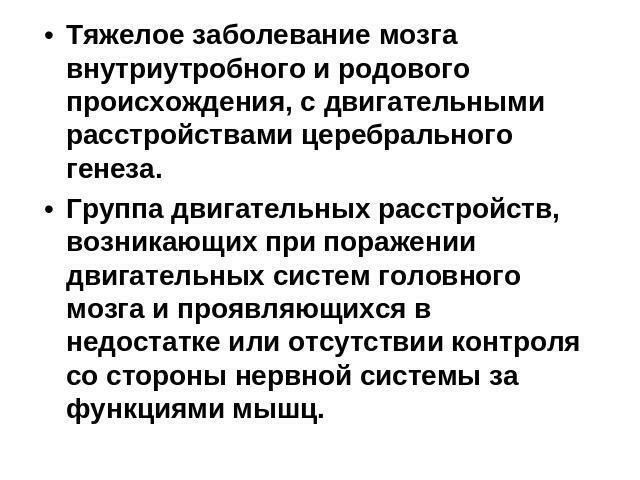
What is cerebral palsy
In pregnancy:
- , mother's diseases that are infectious in nature( rubella);
- hemolytic disease( resulting from the development of renal failure in the fetus or as a consequence of severe Rh-conflict);
- the presence of chronic pathologies in the mother( diabetes, heart failure, hypertension);
- reception by the mother during pregnancy of certain medications( in particular, tranquilizers);
- significant toxicosis.
At delivery:
- early delivery( before the 33rd week), because the brain of the newborn is not yet fully formed;
- birth trauma caused by anatomical features of the mother's reproductive organs( narrow pelvis), rapid delivery, poor presentation of the fetus( pelvic / transverse);
- asphyxia caused by a cord embryo or an abruption of the placenta.
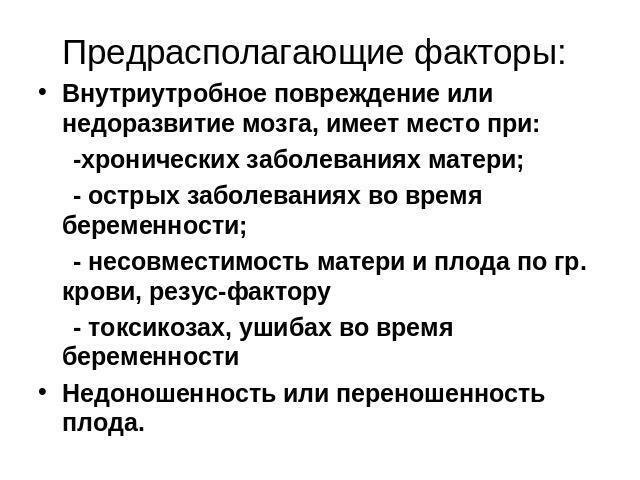
Predisposing factors of cerebral palsy
After delivery:
- development of infections in the infant;
- head injury;
- result of toxicological effects of drugs;
- asphyxia in premature infants due to hypoxia.

Predisposing factors of cerebral palsy. Part 2
Forms of cerebral palsy
There are many factors that lead to the onset of infantile cerebral palsy, and in each specific case, a specific area of the brain is responsible for the functioning of certain organs / systems. Therefore, it is customary to classify cerebral palsy in accordance with the localization of brain damage to the newborn.
| Type of cerebral palsy | Type of brain lesion | Symptoms of |
|---|---|---|
| Spastic diplegia | Presence of single foci of die-off areas of the brain, neoplasm of | may appear. Dysfunction of lower extremities( baby's hands can function normally or remain partially functional).The tonus of the leg muscles is elevated, the infant crouches only with the hands, the legs remain immobile. If you take the baby under the mouse, his legs automatically cross. Disorders of motor functions, as a rule, do not affect the development of intelligence and speech, children, starting from 2-3 years of age, are able to serve themselves |
| Spasmodic tetraplegia | Development of multiple foci of death of brain areas, developmental defects, possible white matter damageright / left hemispheres | Hypertonus of the upper / lower extremities( there may be more noticeable manifestation of limb dysfunction on the left or right side).There are violations of the swallowing function, the motor activity of the child is markedly reduced, there may be epileptic seizures, the child's mental development occurs with deviations. Usually, children suffering from this form of cerebral palsy remain mentally retarded until the end of life. |
| Hemiplegia | Single cerebral hemorrhages | Unilateral hypertension of the extremities( usually right).During the first months of life, these disorders often go unnoticed, acquiring features later. In this case, often there is a wrinkling of the hand, which always remains pressed to the body. Sometimes there is a convulsive syndrome. At the time of the onset of independent walking, such dysfunction has almost no effect, as well as on the mental abilities of the baby |
| Extrapyramidal( hyperkinetic) form | Single lesion of the brain region | Decreased muscle tone, occasional manifestations of hypertonia are possible. The newborn usually does not hold the head well, there are violations of swallowing functions. The child begins to walk late, but on his intellectual development the disease in most cases does not affect |
Each of the possible forms of cerebral palsy is characterized by a degree of severity.
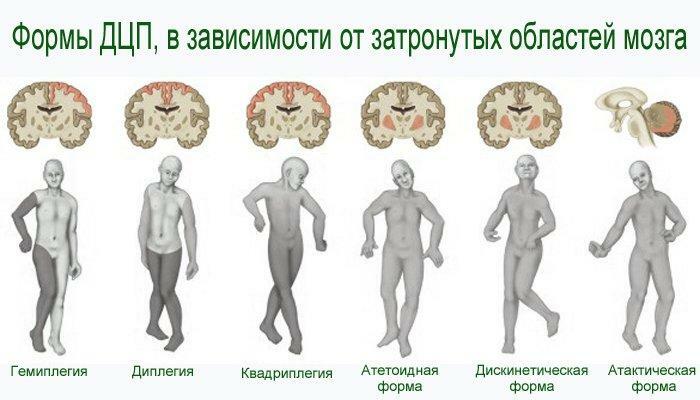
Forms of cerebral palsy
With a mild form of cerebral palsy, the child is able to move / maintain himself without assistance. Such patients go to a regular school, in adult life are able to engage in most types of professional activity.
In cases of moderate disease, children are unable to do without the help of adults, but this does not affect their ability to feel themselves normally in society, there are opportunities to engage in certain types of professional activities.
With severe form of cerebral palsy, the possibility of self-care is extremely limited, such a child will depend on others constantly.
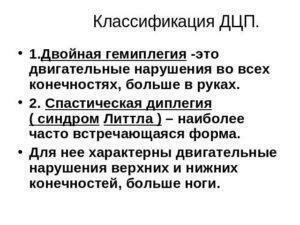 Classification of cerebral palsy
Classification of cerebral palsy 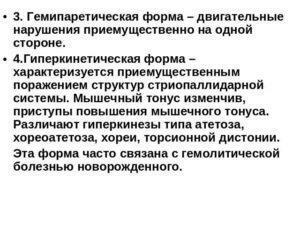 Classification of cerebral palsy. Part 2
Classification of cerebral palsy. Part 2  Classification of cerebral palsy. Part 3
Classification of cerebral palsy. Part 3  Classification of cerebral palsy. Part 4
Classification of cerebral palsy. Part 4 Stages of development of cerebral palsy
The severity of the disease usually correlates with the stages of development of infantile cerebral palsy, which are divided into:
- early;
- initial( in residual form);
- late residual.
Each stage has its own age limits and its own symptoms. In particular, the early stages include manifestations of cerebral palsy observed in infants up to 3-4 months.
The initial stage in residual form correlates with age ranging from 4 months to 3 years.
The late stage in residual form is characterized by a set of late manifestations of cerebral palsy( pathologies of tooth growth, seizures, auditory / visual dysfunctions, deforming of the skeleton), which do not have time to develop at an early age.
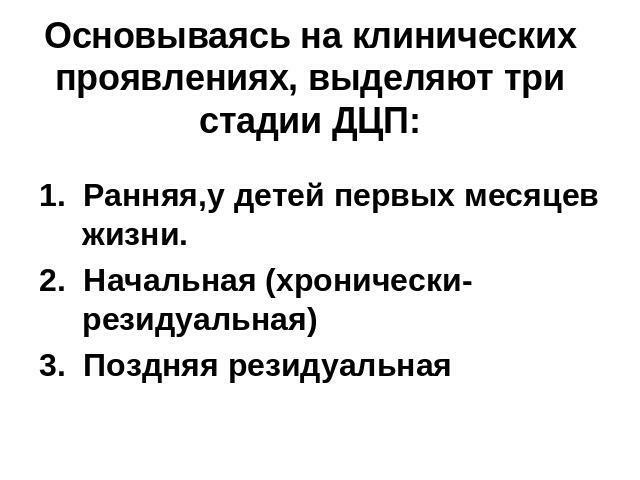
Three stages of cerebral palsy
Consider the main symptoms of the disease in accordance with the age of the baby.
Cerebral palsy in newborns( up to 3 months)
Although most often cerebral palsy is formed during pregnancy, it is very difficult to diagnose the disease independently within the first three months after the birth of the child, since most of the time they sleep, and during wakefulness their motor activity is limitedcharacter. Usually at this stage only cases of an illness in severe form are well recognized.
It is possible to suspect an abnormal observation of a newborn and noting that he has the following symptoms:
- an abnormally long time spent by the baby in a dream;
- stiffness of movements;
- the presence of severe muscle weakness;
- problems with swallowing, chewing, sucking;
- frequent regurgitation accompanied by cough;
- frequent attacks of vomiting;
- sounds, published by the baby, seem unnatural, strange;
- child's sound reaction to external events occurs with a delay.

Signs of cerebral palsy during the first 3 months of a child's life.
Some of these signs of cerebral palsy may appear not in the first days of a newborn's life, but somewhat later, when his mother begins more active courtship for the baby( dressing, bathing, feeding).At such times, his body or limbs may freeze for a while, and there may also be a general muscle weakness when it seems that the child simply can not even crawl.
Cerebral Palsy in 3-4 Months

Signs of cerebral palsy from 2 months and older
As a rule, the first signs of cerebral palsy appear at this age. These are the following symptoms that should alert the parents:
- preserving the reflex manifestations characteristic of newborns( reflex walking syndrome, Moro reflex, crawling reflex);
- the child does not react( or reacts very poorly) to attempts to communicate with his parents;
- very meager facial expressions( or its complete absence);
- frequent emotional disruptions caused by the inability of the baby to control his body;
- involuntary salivation;
- general lethargy, the practical absence of periods of prolonged activity, movements are awkward and slow.

Symptoms of cerebral palsy by the month
Sometimes it seems to parents that the child lags behind in mental development. In some cases, the anomalies of intellectual development do take place, but more often than not, these are deceptive conclusions. With an appropriate approach to the development of the child, his mental abilities will be within the norm.
Cerebral palsy at the age of 4-6 years
The presence of pathology at this age can be manifested by the appearance of the following new symptoms:
- instability of behavior( increased lethargy or excitability);
- lack of symmetry in the position of the child sitting or standing;
- new skills are given to the kid with a delay in relation to the regulatory deadlines;
- the child tries not to use that half of the body, which develops abnormally.
The complexity of diagnosis of the disease persists in this period of the child's development, since up to six months some symptoms( slight hand / chin trembling, low muscle tone) are phenomena considered to be the norm. Usually they pass when a newborn begins to crawl. That is why it is not necessary to rush to establish a diagnosis at this age: if there is cerebral palsy, its symptoms will become more pronounced after a few months.
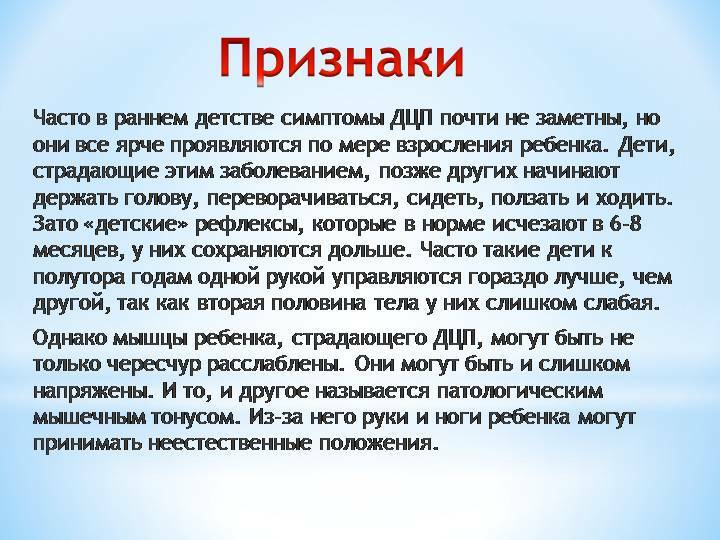
Symptoms of cerebral palsy
IT IS INTERESTING: according to statistics, the diagnosis of cerebral palsy is most often established for preterm infants( about 40% of newborns) or twins / triplets( 11%).The incidence of the disease in boys is higher than in girls( 56% and 44%, respectively).
Diagnosis of the disease
If you suspect your child has the possibility of having cerebral palsy, you should immediately consult a doctor: firstly, a complex of modern studies allows you to diagnose cerebral palsy even in infants, and secondly, the earlier the treatment is prescribed, the higher the chances that the resultssuch treatment will be positive.
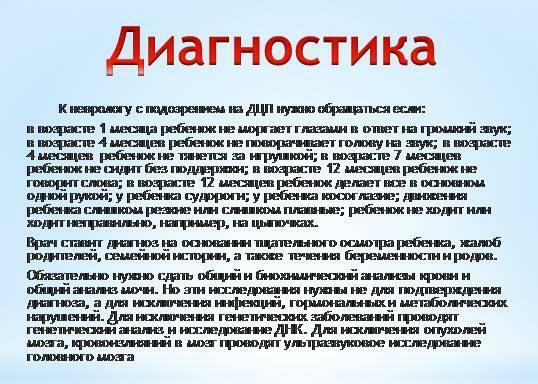
Diagnosis of cerebral palsy
Usually the procedure for diagnosing a newborn for the presence of cerebral palsy requires the following studies:
- visual check of the muscle tone and reflex reactions of the child;
- Ultrasound of the brain - performed if the first procedure revealed abnormalities;
- electroencephalography - a study conducted in the case of a neonatal seizure;
- CT / MRI is assigned if all previous studies did not allow diagnosis of the presence / absence of the disease.

Causes leading to cerebral palsy
Quite often, infants are diagnosed with encephalopathy - a brain damage, usually leading to the development of cerebral palsy. The correct diagnosis is the key to the effectiveness of the treatment, and if the pathology affects only the musculoskeletal system of the newborn, with timely and properly prescribed treatment, there are all chances to achieve improvement in the patient's condition.
Treatment of cerebral palsy
If the disease is diagnosed during the first few months of a child's life, this guarantees the best results in the complex and long-term treatment of cerebral palsy. This is due to the fact that the baby's brain has the greatest potential in terms of restoring its functioning with various lesions precisely in infancy. The main problem is that at early stages, pathology is extremely difficult to detect, especially in mild to moderate forms.

Methods of treatment of cerebral palsy
The rate of treatment of newborns has a pronounced dependence on the detected symptoms. The main efforts are directed to arresting pathologies, preventing their further development. In particular, the common practice is to prescribe medications designed to reduce intracranial pressure in a newborn( medicine with active substance citral or diacarb, intramuscular injection of magnesia).Vitaminotherapy( group B) also contributes to a favorable effect on the metabolic processes occurring in the brain of the newborn.
The second class of drugs with frequency of cerebral palsy is CNS stimulants. It's glutamine, but it rasped, aminalon. For the arrest of seizures are prescribed drugs such as benzonale, luminal, in the presence of symptoms of increased excitability a good effect is demonstrated by sedatives.
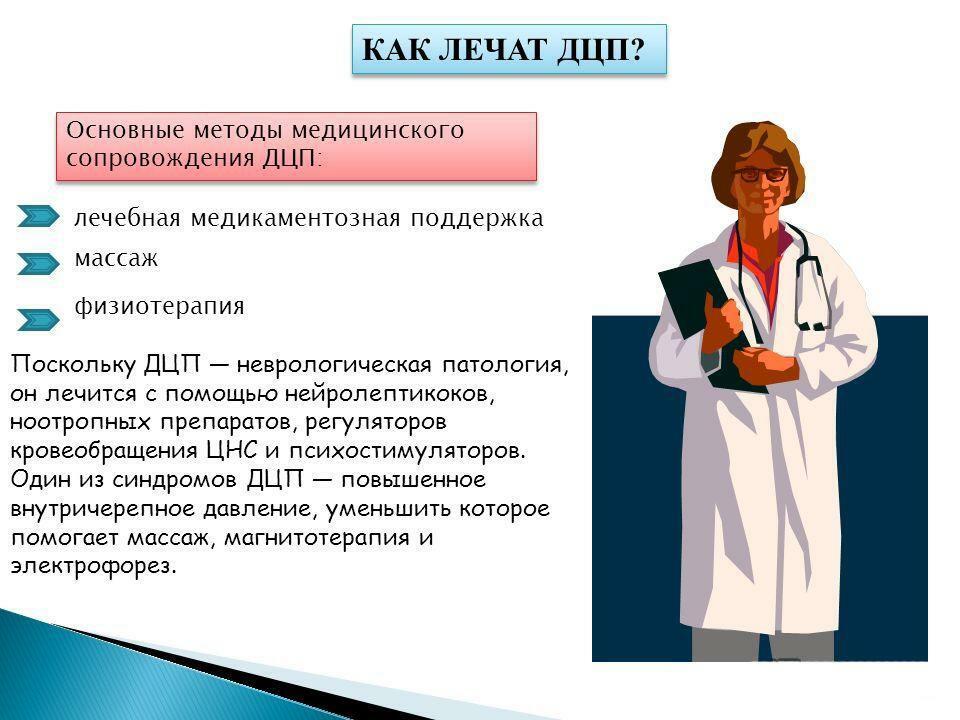
The main methods of treatment of cerebral palsy
The complex treatment of cerebral palsy is not limited to drug therapy: a significant role is given to physiotherapy exercises, special types of massage. It is important not to make even short breaks in the treatment of newborns, which has a beneficial effect on the ability of the baby to absorb new movements and to develop without significant backlogs. The effectiveness of treatment depends largely on the diligence and perseverance of parents, since most exercises and massage should be done daily, or even several times per day.
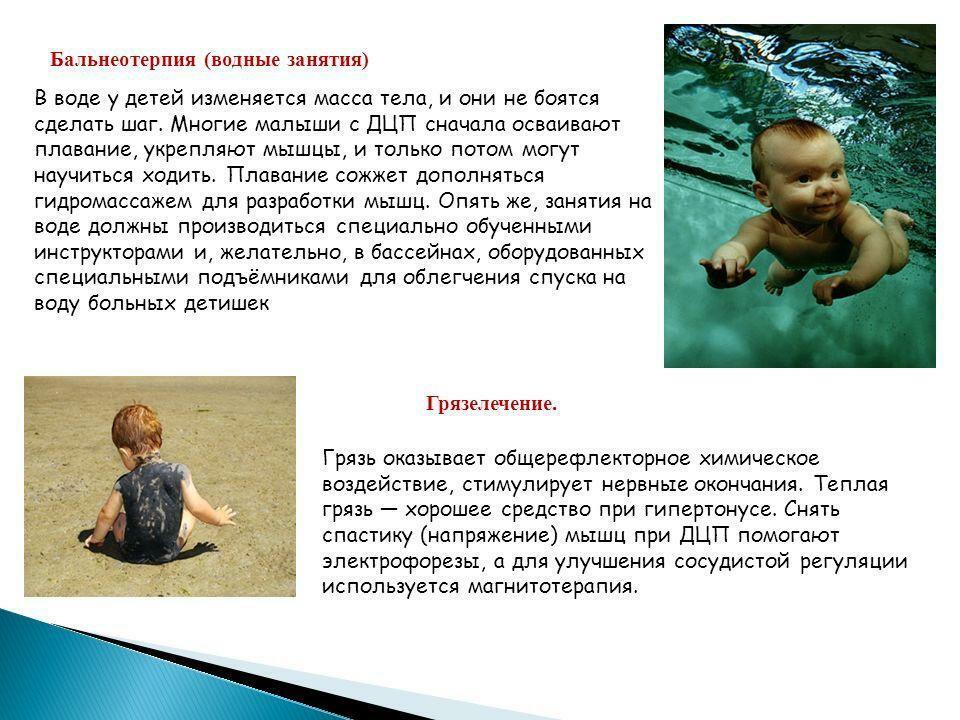
Balneotherapy and mud treatment of cerebral palsy
The effectiveness of the appointment of certain physiotherapeutic procedures( ozocerite, acupuncture, mud baths, balneotherapy, electrophoresis) has been proved.
The "Spiral", "Adeli" suits, pneumatic overalls, which reduce the spasticity of the baby, while allowing the newborn to acquire and consolidate the necessary motor skills, performed well.
Much depends on how mentally balanced the mother of the child, because babies suffering from cerebral palsy often fuss, refuse to perform exercises, resist the conduct of a massage.
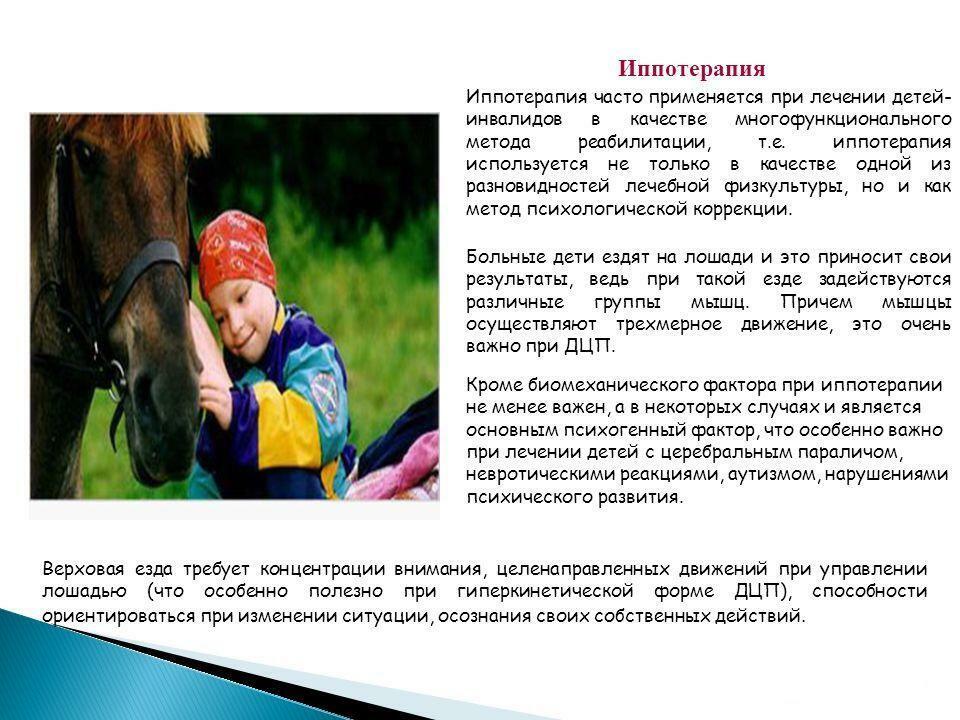
Hippotherapy
IMPORTANT: Cerebral Palsy is a pathology that progresses only for a short time. At the age of up to one year, certain pathologies of the brain are reversible. Therefore, this diagnosis should not be taken as a sentence: with sufficient persistence and patience on the part of parents, the result of treatment will not be long in coming.
Video - Children's cerebral palsy. How to recognize the disease
What parents need to know
Parents, in order not to miss the first symptoms of such an unpleasant pathology in a newborn, must show maximum attention to the child, especially in cases of various abnormalities during pregnancy / childbirth. According to statistics, treatment, begun at the age of up to three years, in 60-75% of cases allows to restore the normal functioning of the baby's brain. At a later age, achieving such an impressive effect is much more difficult.



